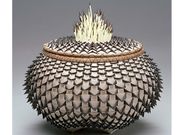Reactive dye
Description
A water-soluble synthetic dye that reacts with molecular groups in a fiber to form a covalent bond. For example, a fiber-reactive dye with an azo group can bind to the hydroxyl groups in cellulose. Reactive dyes were first discovered in 1954 by Rattee and Stephens at ICI and they were marketed as Procion dyes in 1956. Since then, over one hundred varieties have been patented. Fiber reactive dyes have bright colors that are both lightfast and washfast. They are most commonly used on Cellulose fibers but also react with the hydroxyl or amino groups found in Wool, Silk, Nylon, Acrylic, and Acetate fibers.
Synonyms and Related Terms
fiber reactive dyes; fiber-reactive dyes; fibre-reactive dyes (Br.); colorante reactivo (Esp.); corante reactivo (Port.)
Examples include: Procion [ICI]; Cibacron [Ciba-Geigy]; Drimarene
Physical and Chemical Properties
Soluble in water and some organic solvents.
Resources and Citations
- G.S.Brady, Materials Handbook, McGraw-Hill Book Co., New York, 1971
- Richard S. Lewis, Hawley's Condensed Chemical Dictionary, Van Nostrand Reinhold, New York, 10th ed., 1993 Comment: produced 1953
- Hoechst Celanese Corporation, Dictionary of Fiber & Textile Technology (older version called Man-made Fiber and Textile Dictionary, 1965), Hoechst Celanese Corporation, Charlotte NC, 1990
- Rosalie Rosso King, Textile Identification, Conservation, and Preservation, Noyes Publications, Park Ridge, NJ, 1985 Comment: discovered 1954 by Rattee et al (I.C.I.)
- Matt Roberts, Don Etherington, Bookbinding and the Conservation of Books: a Dictionary of Descriptive Terminology, U.S. Government Printing Office, Washington DC, 1982
- Van Nostrand's Scientific Encyclopedia, Douglas M. Considine (ed.), Van Nostrand Reinhold, New York, 1976
- Website: www.straw.com/sig/dyehist;
- Wikipedia: http://en.wikipedia.org/wiki/Reactive_dyes (Accessed Mar. 1, 2006) - invented in 1954 by Rattee and Stephens at ICI Dyestuffs Division
